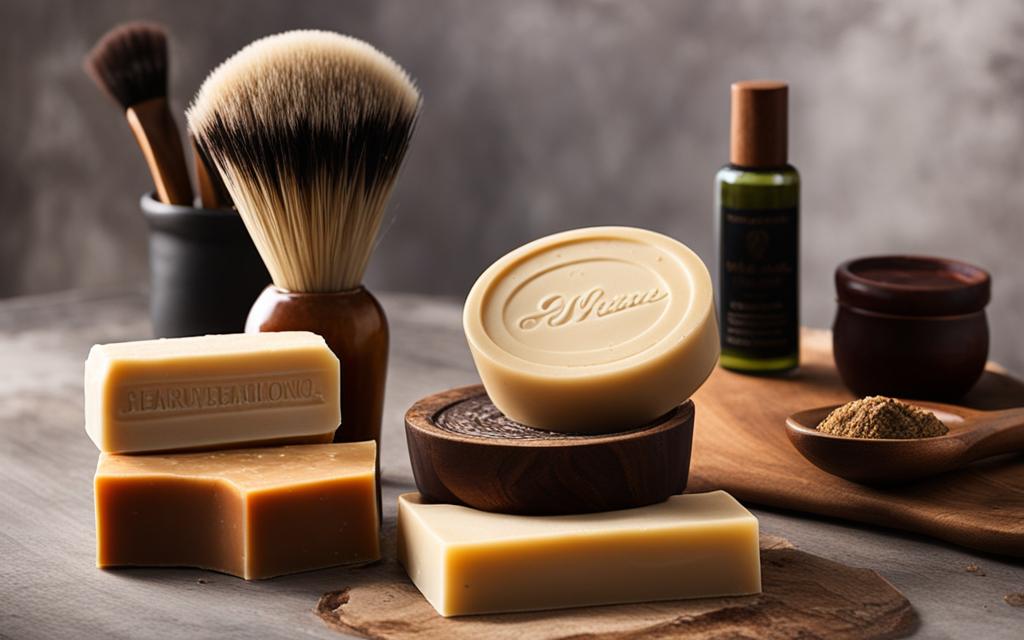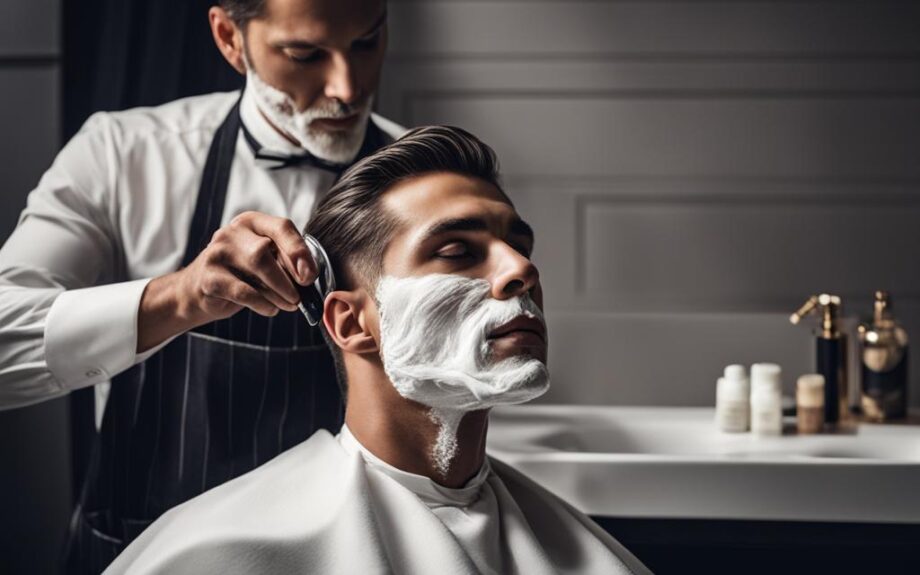The debate between shaving cream and shaving soap has been ongoing for years, with no definitive answer. It ultimately comes down to personal preference and skin type. While both shaving creams and soaps produce a creamy lather and offer a close shave, they have slightly different ingredients and textures. Choosing between the two depends on factors such as fragrance preference, skin sensitivity, and base ingredients (tallow-based or vegan). It’s important to read the ingredient list to find the best option for your needs.
Key Takeaways:
- Shaving cream and shaving soap both provide a creamy lather and a close shave.
- The choice between the two depends on personal preference and skin type.
- Consider fragrance preference, skin sensitivity, and base ingredients when choosing a shaving product.
- Read the ingredient list to ensure the best option for your needs.
- Experimenting with different products can help you find your perfect match.
The Story Behind the Debate
The debate between shaving cream and soap has a long and fascinating history. It all began in 1919 when Frank Shields introduced the world to the first canned shaving cream, known as Barbasol. This invention revolutionized the shaving industry by providing a convenient and ready-to-use alternative to the traditional method of using a shaving brush and soap.
Barbasol quickly gained popularity for its ease of use and accessibility. Shaving cream enthusiasts embraced the new product, praising its convenience and ability to produce a rich lather effortlessly. However, not everyone was thrilled with this modern development.
Traditionalists who cherished the ritual of a classic wet shave with shaving soap and a brush felt that the introduction of shaving cream disrupted the time-honored tradition. They valued the artisanal craftsmanship and the unique fragrance of traditional shaving soaps, which they believed provided a superior shaving experience.
“The introduction of canned shaving cream was met with mixed opinions. While some praised its convenience, others viewed it as a departure from the true essence of traditional shaving.”
Since then, the debate between shaving cream and soap has persisted. Advocates on both sides passionately argue for the superiority of their chosen product, fueling ongoing discussions and comparisons.

Despite the debate, it’s important to recognize that both shaving cream and soap have their unique advantages and appeal to different individuals. The decision between the two ultimately comes down to personal preference, skin type, and the desired shaving experience.
In the upcoming sections, we will explore the characteristics, ingredients, and pros and cons of both shaving cream and soap, helping you make an informed decision based on your individual needs.
What Are Shaving Soaps?
Shaving soaps have been a staple in grooming routines for centuries, offering a rich lather and a smooth shaving experience. They come in various types, each with its own unique properties. Let’s explore the different shaving soap types:
Triple Milled Soap
Triple milled soaps are highly sought after for their exceptional quality. The triple milling process involves grinding the soap three times to create a dense and luxurious lather that provides excellent cushioning and glide during shaving. These soaps are long-lasting and offer a superior shaving experience.
Croap Soap
Croap soap, derived from the combination of cream and soap, offers the best of both worlds. It provides the convenience of easy lathering without the need for a brush. Croap soaps produce a creamy, moisturizing lather that ensures a comfortable shave.
Semi-Hard Soap
Semi-hard soaps strike a balance between shaving creams and traditional soaps, combining the best attributes of both. They have a texture that is harder than creams but softer than soaps, making them easy to load onto a brush. Semi-hard soaps offer excellent lathering capabilities and are known for their nourishing and protective properties.
Shaving soaps typically contain a blend of ingredients that contribute to their performance. These may include glycerin, tallow, essential oils, and various fragrances. The choice of soap type ultimately depends on personal preference and shaving style.

| Shaving Soap Type | Description |
|---|---|
| Triple Milled Soap | A high-quality soap that undergoes a triple milling process to create a dense lather and provide an exceptional shaving experience. It is long-lasting and offers superior cushioning and glide. |
| Croap Soap | A combination of cream and soap that provides the convenience of easy lathering without a brush. Croap soaps produce a creamy, moisturizing lather for a comfortable shave. |
| Semi-Hard Soap | A soap with a texture that is harder than creams but softer than traditional soaps. It balances lathering capabilities with nourishing and protective properties. |
Ingredients in Shaving Creams and Soaps
The key to a smooth and comfortable shave lies in the ingredients of your shaving cream or soap. Both shaving creams and soaps are designed to lubricate, hydrate, and moisturize the skin, but they feature different formulations to achieve these benefits.
Shaving creams often incorporate natural oils like jojoba oil and shea butter, which provide excellent moisturization and nourishment to the skin. These oils help to soften the beard for a smoother and more effortless shaving experience. Additionally, some creams may contain soothing ingredients like aloe vera and menthol, which offer a refreshing sensation and help to calm any potential skin irritation.
On the other hand, shaving soaps often contain tallow, stearic acid, and glycerin as their main ingredients. Tallow-based soaps are known for their exceptional cushion and glide, allowing the razor to effortlessly glide over the skin and deliver a close shave. Glycerin-based soaps, on the other hand, provide intense hydration and contribute to a smooth texture.
Other beneficial ingredients commonly found in shaving creams and soaps include vitamin E, which offers antioxidant properties and helps to nourish the skin; aloe vera, known for its soothing and calming effects; and menthol, which provides a cooling sensation that revitalizes the skin and leaves it feeling refreshed.
When it comes to choosing between tallow-based and glycerin-based soaps, it’s a matter of personal preference and the needs of your skin. Tallow-based soaps excel in providing a smooth and comfortable shave, while glycerin-based soaps offer intense hydration and a luxurious lather. Ultimately, finding the right combination of ingredients that suits your skin type and shaving routine is key to achieving optimal results.
| Shaving Creams | Shaving Soaps |
|---|---|
| Natural oils (jojoba oil, shea butter) | Tallow |
| Soothing ingredients (aloe vera, menthol) | Stearic acid |
| – | Glycerin |
| – | Vitamin E |
As seen in the table above, shaving creams often contain natural oils, while shaving soaps utilize tallow, stearic acid, and glycerin for their creamy lather and moisturizing properties. The inclusion of soothing ingredients and antioxidants further enhances the overall shaving experience, leaving your skin feeling nourished and refreshed.
Pros and Cons of Shaving Creams and Soaps
When it comes to choosing between shaving creams and soaps, it’s important to consider the pros and cons of each option. While shaving creams offer convenience and a quick lather, there are some drawbacks to be aware of. On the other hand, shaving soaps require a bit more skill and time to lather but come with their own set of benefits.
Pros of Shaving Creams:
- Convenience: Shaving creams typically come in a convenient tube or can, making them easy to use and travel-friendly.
- Quick lather: Shaving creams produce a creamy lather quickly, allowing for a speedy shaving process.
- Suitable for beginners: The ease of lathering and application makes shaving creams a popular choice for those new to shaving.
Cons of Shaving Creams:
- Potentially harmful ingredients: Cheaper canned shaving creams may contain ingredients that can irritate the skin or have other adverse effects. It’s important to read the ingredient list and choose high-quality products.
Pros of Shaving Soaps:
- Natural ingredients: Shaving soaps often contain natural ingredients, making them a preferred choice for those who prioritize using products with wholesome elements.
- Customizable experience: Shaving soaps come in a variety of scents and textures, allowing for a more personalized shaving experience.
Cons of Shaving Soaps:
- Skill and time required: Lathering shaving soaps properly may take some practice and additional time compared to using shaving creams.
| Shaving Creams | Shaving Soaps |
|---|---|
| Convenient and travel-friendly | Contain natural ingredients |
| Quick lather | Customizable scents and textures |
| Suitable for beginners | Requires some skill and time for lathering |
| Potentially harmful ingredients in cheaper options |
Both shaving creams and soaps have their advantages and considerations. Ultimately, the choice depends on individual preferences and needs. If convenience and quick lathering are important, shaving creams may be the way to go. On the other hand, if using natural ingredients and having a customizable experience are priorities, shaving soaps may be the better option.
With a better understanding of the pros and cons of each, you can make an informed decision and find the perfect shaving product for your needs, leaving you with smooth and comfortable shaving experiences every time.
Conclusion
In conclusion, when it comes to choosing between shaving cream and soap, it all boils down to personal preference and the specific needs of your skin. Both options can deliver a smooth and comfortable shave when used correctly. The decision should take into account factors such as fragrance, skin sensitivity, and the type of ingredients you prefer.
Whether you opt for a high-quality shaving cream with natural oils or a traditional shaving soap with tallow or glycerin, the key is to find a product that suits you best and provides the desired shaving experience. Experimenting with different options can be a fun and effective way to discover your perfect match.
So, next time you’re in front of the mirror, pondering over shaving cream or soap, trust your instincts and choose what feels right for you. After all, achieving a close and irritation-free shave is what truly matters.
FAQ
What is the difference between shaving cream and shaving soap?
Shaving cream and shaving soap have slightly different ingredients and textures. Shaving creams often come in a convenient, quick-to-lather form, while soaps require some skill to lather and may take longer to produce a sufficient lather.
How do I choose between shaving cream and shaving soap?
The choice between shaving cream and soap depends on personal preference and the specific needs of your skin. Factors to consider include fragrance, skin sensitivity, and the type of ingredients you prefer.
What are the benefits of using shaving cream?
Shaving cream is convenient and produces a quick lather, making it suitable for beginners. It often contains natural oils like jojoba oil and shea butter, which lubricate, hydrate, and moisturize the skin.
What are the benefits of using shaving soap?
Shaving soap offers a more customizable experience with various scents and textures. It may contain ingredients such as glycerin, tallow, and various fragrances, providing excellent cushion and glide for a smooth shave.
What ingredients are commonly found in shaving creams?
Shaving creams often contain natural oils like jojoba oil and shea butter, as well as other ingredients like vitamin E, aloe vera, and menthol. These ingredients aim to lubricate, hydrate, and moisturize the skin.
What ingredients are commonly found in shaving soaps?
Shaving soaps may include tallow, stearic acid, glycerin, and various fragrances. Tallow-based soaps provide excellent cushion and glide, while glycerin-based soaps offer hydration and a smooth texture.
What are the pros and cons of shaving creams?
Shaving creams are convenient and produce a quick lather, making them suitable for beginners. However, some cheaper canned shaving creams may contain potentially harmful ingredients.
What are the pros and cons of shaving soaps?
Shaving soaps require some skill to lather and may take longer to produce a sufficient lather. However, they often contain natural ingredients and offer a more customizable experience with various scents and textures.
